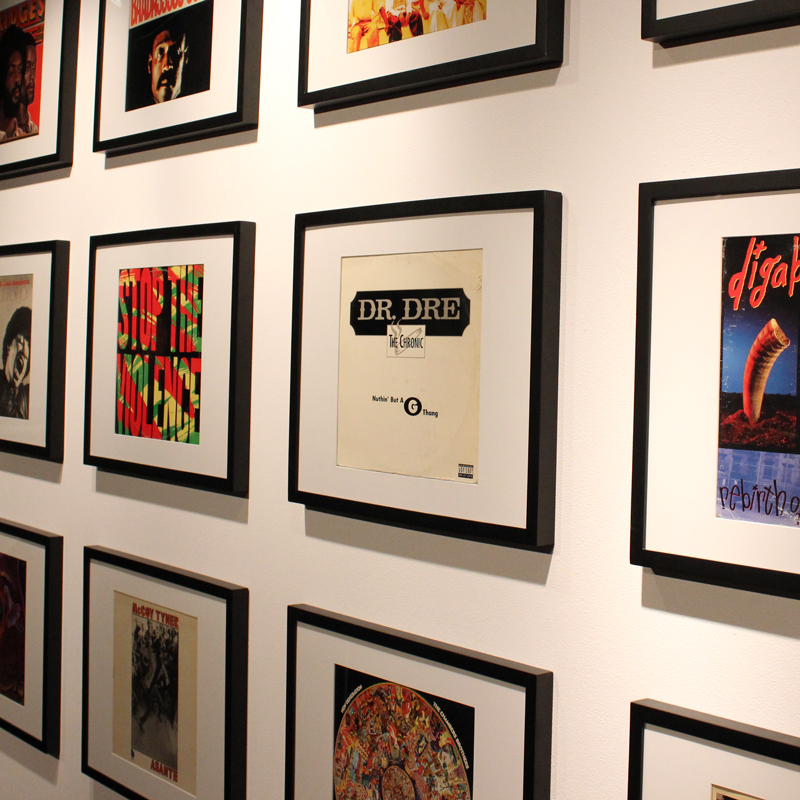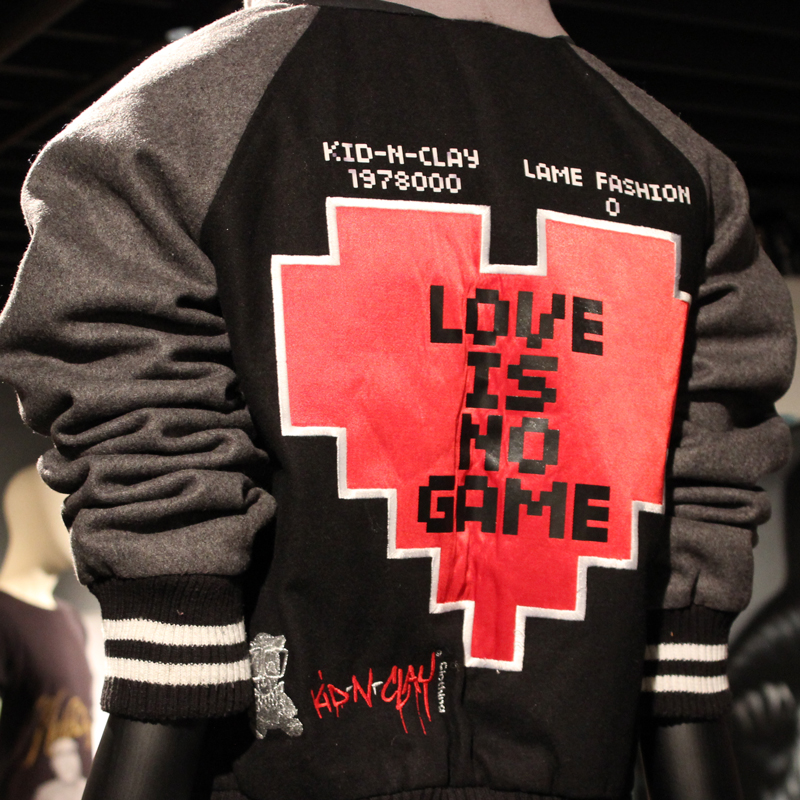Living Like Kings: The Unexpected Collision of Chess and Hip Hop Culture explores the surprising ways in which the ancient game of chess intersects with the powerful, creative expression in hip hop culture.
On View: October 9, 2014 - April 26, 2015
The mission to celebrate the role of chess and its intersection with history and culture provides the World Chess Hall of Fame (WCHOF) with incredible opportunities to explore a variety of subjects both obviously and not so seemingly connected to the ancient war game. In the Fall of 2014 and the Winter of 2015, the WCHOF is examining the unexpected collision of chess and hip hop culture. Inspired by the work of Adisa Banjoko and the Bay Area-based peace and knowledge-promoting Hip-Hop Chess Federation, Living Like Kings centers on an immersive, multimedia experience created by Saint Louis artist, Benjamin Kaplan. Nicole Hudson executive produced this 27-minute video installation, commissioned exclusively by the WCHOF for this show. It includes archival and original videos, music, photography, custom-designed type and illustrations, and a series of interviews with figures from both the hip hop and chess worlds. The first-floor gallery will also include murals featuring chess clocks and boomboxes by local street artist Peat “EYEZ” Wollaeger. By focusing on Saint Louis talent and experts, the WCHOF is ensuring that the exhibition showcases the living, breathing regional scene.
The birth of hip hop in the 1970s coincided with a surge of interest in chess among Americans, inspired by Bobby Fischer’s landmark victory in the 1972 World Chess Championship. As a new generation of players enthusiastically competed over the board, hip hop flourished in the nation’s cities. Living Like Kings celebrates themes that chess and hip hop grew to share: history, strategy, spirituality, process, creativity, education, and symbolism. Through this inspirational presentation, visitors will see powerful connections between the two cultures.
In addition to Kaplan’s full-gallery experience, the WCHOF will also dedicate one floor to an interactive Learning Lab. Evolving over the course of Living Like Kings, the Learning Lab will host multiple projects and exhibitions, exploring aspects of both chess and hip hop culture. Some will last the span of an evening, while others will run the length of the show. Through photography exhibitions, graffiti and lettering murals, music and video stations, hands-on art activities, and educational presentations, the World Chess Hall of Fame hopes to present visitors with opportunities to both contribute to this changing presentation and make it their own.
The Learning Lab will open with graffiti-inspired exhibitions by two local artists. Photographer Adrian O. Walker’s powerful images of graffiti from the Saint Louis area showcase an art form that many consider vandalism, but is often beautiful and extremely vibrant. Daniel Burnett is curating Pieces and Placement, a series of murals that will be created by a team of artists throughout the run of Living Like Kings. Each month, a new artist will create a work based upon a different chess piece, beginning with Burnett’s images of the pawn. As the entire Living Like Kings project grows over the six months of the show, the World Chess Hall of Fame will seek to inspire understanding and learning, acceptance and tolerance, and a deeper appreciation for both the game of chess and the rich history and influence of hip hop.
—Shannon Bailey, Chief Curator, and Emily Allred, Assistant Curator, World Chess Hall of Fame, 2014
The King’s Remix

Living Like Kings is, at its core, the essence of hip hop: a remix, a mashup, a sum of parts. It is a symphony of rhythm and rhyme constructed from individual shards, disparate sources—samples, if you will—combining to tell a complete story. As in any hip hop experience, history rides shotgun. A fresh form is created, built upon the foundation laid by its forefathers.
Living Like Kings also embodies the spirit of chess. The piece is strategic, thoughtful, and passionate. Steeped in years of preparation and knowledge, it is constructed from small, incremental moves that build into a powerful crescendo, using misdirection and illusion to create a sense of surprise.
A study in contrasts, Living Like Kings explores the collision of hip hop and chess as well as the contradictions inherent in the king, who is the central character of the piece. He is the most important piece on the chessboard, the powerful ruler who must be protected at all costs. Players sacrifice other pieces to defend his position, and they execute and abandon entire strategies to safeguard his status. However, the king is also one of the most limited pieces on the chessboard. Only able to move one step at a time, his existence is fragile, and he must rely on others to defend him, often seeking shelter in corners and behind other pieces. He is simultaneously the ultimate insider and the “other.”
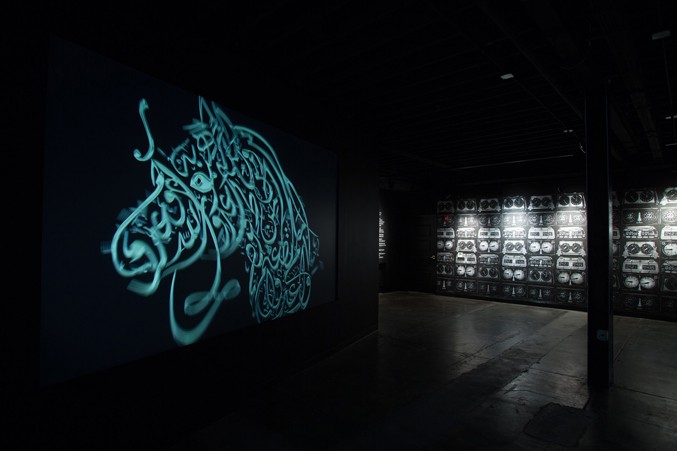
This fascinating contradiction is both the thesis at the heart of Living Like Kings and the engine that drives my inspiration for the piece. I also drew insight from the film work of François Girard, Errol Morris, Adam Curtis, and Stan Brakhage; the design work of Kyle Cooper; the innovative radio work of Joe Frank, Studs Terkel and Jad Abumrad; the sound compositions of John Cage; the collage work of Robert Rauschenberg; and the 360 degree film I saw at Epcot Center when I was 15 years old.
I grew up in the 1970s and 1980s in rural, Central Pennsylvania, at the northern tip of the Appalachian Mountains. Being both Jewish and artistic, I was somewhat of an anomaly for that area, an “other” for all intents and purposes. I have carried this sense of being on the outside with me throughout my life.
When I was very young, my father and grandfather built a family room addition to our house, as my parents started adding more kids to their growing family. The room was close to 1,000 square feet and housed the kitchen table, the couch and TV, bookshelves brimming with books, a desk for my father’s “paperwork,” a bathroom, and a laundry room. It is where I did my homework, watched my Saturday morning cartoons, ate my family dinners, played my video games, and where, as a 6th grader, I began my journey towards hip hop. The family room had a linoleum floor and, as you may know, this makes for a great surface for a young boy to try out his dance moves.

During my formative pre-teen years—that time where you begin to expand your world beyond your parent’s record collection and whatever was on Casey Kasem’s top 40—I acquired a record called Breakdance, distributed by KTel, at the one record store located in the one mall on the outskirts of town. The cover was beautiful, depicting a purple graffiti cityscape above a brick wall covered in tags. It beckoned you inside, where it promised to teach you the Moonwalk, the Electric Boogie, how to do footwork, headspins, and more—all the while introducing you to artists such as Grandmaster Flash and the Furious Five, The Sugar Hill Gang, and Spoonie Gee. This record blew my mind. Played over and over and over again, it became the gateway to a new way of thinking about music, fashion, and being a teenager.
I can tell you this: there were no visible signs of a hip hop community in the small town in which I grew up. While my friends were learning about Zeppelin and the Stones and wearing ripped faded jeans, I was absorbing Slick Rick and the Treacherous Three and wearing Adidas and makeshift Kangol hats. The mystical MCs, the shamanistic DJs, and the hyper-kinetic dancers all sparked my imagination and creativity. The electronic beats and sampled grooves resonated with me. The fashion intrigued me, and the dance moves...well, let’s just say there weren’t many seventh grade kids in rural Pennsylvania throwing breakdance parties in their parents’ living room whilst attempting to scratch records on their console stereo.
As we flash forward to present day, I am presented with the opportunity to pay homage to those early heroes in a unique and innovative way, with that culmination of experience manifesting itself as Living Like Kings. My goal is to envelop the viewer in a multi-sensory narrative. Weaving together hundreds of images, thousands of seconds of film footage, millions of pixels, and hours and hours of interviews, Living Like Kings surrounds viewers on two sides with the unique perspectives of those whose tangible experiences place the viewer within an authentic conversation. Two screens battle it out, like in a chess game or a B-Boy battle.
—Benjamin Kaplan, Creator, Living Like Kings, 2014
Photography by Michael DeFilippo
64 Squares in the Cypher
At a glance, the idea of fusing chess and hip hop may seem so absurd that it could be easily dismissed. But the streets of New York, Chicago, San Francisco, and Washington, D.C. don’t lie. In each city you will find clusters of people gathered in the parks going hard on the sixty-four squares of infinite combat. Listen to what is being played as the opponents lock horns—it’s hip hop.
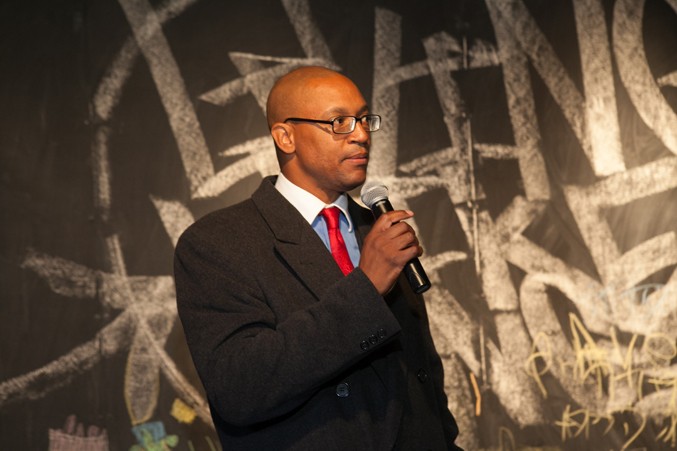
Adisa Banjoko speaking during the Living Like Kings opening reception
Photography by Carmody Creative
Street chess grew in popularity across America in the 1970s as hip hop emerged from its embryonic stage. On the corners where street chess thrived, rap, DJ, and dance battles also took place. The same strategies and insight required to win on the chessboard assisted those clashing on the mic, the turntable, and the dance floor. Like the game of chess, each of the elements of hip hop became defined by the beautiful irony that they were war games that could also be used to promote peace around the world.
In 1993 the Wu-Tang Clan released Enter the Wu-Tang (36 Chambers), which shifted the axis of contemporary hip hop culture through innovative, street-tough lyrics blending chess and martial arts references. The Wu-Tang Clan, most notably RZA and GZA, remain firmly at the core of a group of MCs dedicated to perfecting the fusion of chess and hip hop. Surrounding this nucleus are the works of myriad MCs, including artists like Public Enemy, X-Clan, Will Smith, Apathy, and Jay-Z. Every few months a new rap lyric, album cover, or music video utilizes the game of kings to illustrate ideas about street survival, politics, history, and philosophy.

RZA from the Wu-Tang Clan signing autographs during the Living Like Kings opening reception
Photography by Austin Fuller
The lessons one can learn from the mic and the chessmen are universal in nature, transcending race, class, faith, and culture. Rap and chess require the use of both logic and intuition, analytical, and creative thinking. They teach us that patience always overcomes power and that actualizing our good thoughts is an art within itself. Ultimately, we hope that the two activities help us to become better human beings, students, citizens, neighbors, and friends to those unlike us.
Not all of the lyrics are sugar-coated or filled with positivity. Hip hop is an art born from the souls of autodidactic poets, painters, dancers, and DJs. Like hustlers playing chess on the street to eat, everything is not all fun and games. Nevertheless the bulk of what connects hip hop, one of the most popular music forms, and chess, one of the oldest games on earth, is deeply inspirational and educational.
—Adisa Banjoko, CEO, Hip-Hop Chess Federation, 2014
About the Curators
Shannon Bailey, Chief Curator, World Chess Hall of Fame
Shannon Bailey is Chief Curator at the World Chess Hall of Fame. She most recently served as the Director of Institutional Giving at the Contemporary Art Museum Saint Louis. Prior to that, she was the Director of Art Galleries at Stephen F. Austin State University in Nacogdoches, Texas.
In addition to her museum work, Shannon has taught university-level art history classes at Cleveland State University, Stephen F. Austin State University, and Saint Louis University. Shannon holds a Master of Arts in Art History and Museum Studies from the Case Western Reserve University/Cleveland Museum of Art joint program and a Bachelor of Arts in Art History and Museum Studies from Juniata College.
Emily Allred, Assistant Curator, World Chess Hall of Fame
Emily Allred is Assistant Curator at the World Chess Hall of Fame. Prior to working at the WCHOF, she was the Research Assistant in the American Art Department at the Saint Louis Art Museum and the Researcher and Collections Manager for the John and Susan Horseman Collection. Emily has contributed to publications for the two institutions. She has a Master of Arts in History and Museum Studies from the University of Missouri-St. Louis and a Bachelor of Arts in Art History and Communications from the University of Missouri-Columbia.

About Benjamin Kaplan
A nationally-recognized artist, Kaplan is the vision behind the installations Living Like Kings (The World Chess Hall of Fame), Currents (COCA) and Storycubes Sukkah (Sukkah City STL); documentary projects such as McNett Country (Stl Film Festival, Flash Film Festival), Brothers in Tone (National Public Radio), and String Theory; and music videos for soul artist Brian Owens and Magnolia Summer. Kaplan’s film and design work has been acclaimed by The Tellys, Communication Arts Magazine, How Magazine, Print Magazine, Create Magazine, The Addies, and AIGA.
A musician, songwriter, composer, and producer, Kaplan is the leader of the avant-musical project The Vaad, which released its debut recording Kissing the Sea on the Lips, to critical praise in 2012 and is poised to release a new recording in December. He is also the co-founder of the cultural wayfinding project Commonwealth and the founder of pioneering Applied Storytelling firm, Act3.
Kaplan holds a Bachelor of Fine Arts degree in Film and Television Production from the Tisch School of the Arts at New York University and spent 10 years on the faculty of the Sam Fox School of Design and Visual Arts at Washington University.
Learn more about Benjamin Kaplan and his work at www.thisisact3.com/ and iheartbuffets.com/.
About Nicole Hudson

Nicole Hudson has spent her career applying digital media to products in industries ranging from Broadway to finance to journalism. A Northwestern University grad, Nicole has managed the online brands for shows like Les Misérables and The Phantom of the Opera, worked on web development, ticketing and calendar conversion and ad network development with clients such as the Boston Symphony Orchestra and Lincoln Center and tackled online tools and branding for companies like the New Yorker and Goldman Sachs. On the ad agency side, she oversaw national digital campaigns and one-to-one marketing products for AT&T. She has managed web, print, outdoor and on-air production for TV and radio stations, hotels and real-estate developments.
Her 6 years on the business side of the non-profit start-up St. Louis Beacon have given her a front row seat for the transformation happening in local information and the opportunity that digital platforms bring. Nicole consults independently with individuals, organizations and brands on communication strategy, content development and the general navigation of digital waters.
Adisa Banjoko

Adisa Banjoko is a pioneer in creating much of the national discussion on the value of hip hop and chess. He has lectured at Harvard University, San Francisco State and other centers of learning to teach its overlapping history and culture. He founded the
Hip Hop Chess Federation in 2006 to help at-risk kids make better life choices. Banjoko spreads his philosophy of nonviolence to young people across the country, teaching them to use the strategies of music, chess, and martial arts as tools for self mastery and success.
Daaim Shabazz

Daaim Shabazz is a Chicago native and has been involved with chess in various capacities from his time as an Illinois Junior Champion until his latest role as a chess journalist. Thirteen years ago, he launched
The Chess Drum, which has become one of the world’s most visibly active chess sites. The goal of the site is to show the universality of chess including an emphasis on the African Diaspora. He has traveled widely to cover chess events, including U.S. Championships and several Chess Olympiads. While his primary skills have been chess journalism and public relations, he has also remained an active player at the expert level. Today, Shabazz lives in Tallahassee, Florida, where he is a member of the Tallahassee Chess Club and the Florida Chess Association Board of Directors. He is an Associate Professor at Florida A&M University where he has taught Global Business since 1998.
Eugene Brown
It was while serving his time for bank robbery that Eugene Brown finessed his chess skills and realized that he had been living his life with no concern for his endgame. Since then, he has become a successful real estate agent, raised a family, and founded the Big Chair Chess Club in Washington, D.C. Brown believes that chess holds great potential as a tool for mentoring youth, and teaches students to “think before you move.” This no-excuses mentality enables students to accept full responsibility for their choices on and off the board. His story has even inspired the film Life of a King, starring Cuba Gooding, Jr.
WGM Jennifer Shahade

Women’s Grandmaster Jennifer Shahade is a Philadelphia-based writer, games player and commentator. She is a two-time U.S. Women’s Chess Champion, the author of
Chess Bitch and
Play Like a Girl, and co-author of
Marcel Duchamp: The Art of Chess. Jennifer is also the editor of
Chess Life Online and has contributed to many publications, including the
New York Times and
Cardplayer Magazine. Forever in search of new ways to present games, Jennifer created roulette chess with Larry List. She also created hula chess and naked chess with Daniel Meirom, and the two continue to share their game-inspired video art on
PokerFairytale.com. Jennifer has traveled the world to perform chess exhibitions and lecture on chess, culture, and strategy. She is particularly invested in promoting chess to girls and women, both through her books and in teaching at 9 Queens Academy, which seeks to empower underserved students.
Joe Schloss
Joe Schloss is an ethnomusicologist and author with a fervent focus on hip hop. His first title, Making Beats: the Art of Sample-Based Hip Hop, presents a thorough investigation of the history and social framework of hip hop production. This is the first scholarly work to present sampling and DJing as the art forms they truly are. His second book, Foundation: B-boys, B-girls and Hip-Hop Culture in New York gives a sensitive report of the daily lifestyles and processes of creation behind hip hop. Schloss is also the Adjunct Assistant Professor of Black and Latino Studies at Baruch College at the City University of New York.
GM Maurice Ashley

Maurice Ashley was born in Kingston, Jamaica, raised in Brooklyn, New York, and jumped into history books by becoming the first ever African-American International Grandmaster. He is a firm believer in the character-building potential in chess, and his book
Chess for Success crystallizes his vision for the game’s benefits, particularly for at-risk youth. He spreads his love for chess through his
Learn Chess! app for smartphones. Ashley also serves as Joint Fellow at Harvard and MIT, a partnership which seeks to fuse games and technology to maximize their potential. Ashley continues to share his motivational message with universities, businesses, chess clubs and non profit organizations around the globe.
DJ QBert
Richard Quitevis sprang from San Francisco as QBert, the DJ that shocked the world with his skratching skills at the DMC World DJ Championships. As a member of The Invisibl Skratch Piklz, QBert advanced the culture of skratching as a serious form of music, and helped develop the phonograph turntable as a respectable instrument.In addition to an impressive album history, QBert continues his mission to promote the art and culture of skratching through the media management company Thud Rumble LTD., which he co-founded with Yogafrog in 1996, and QBert Skratch University, where he seeks to inspire the next generation of musicians.
Works Featured in the Exhibition
Living Like Kings Film Credits
- Conceived & Created by
- Benjamin Kaplan
- Executive Producer
- Nicole Hudson
- Inspiration
- Adisa Banjoko
- Susan Barrett
- Images
- Adrian Walker
- Benjamin Kaplan
- Brad Fann
- Daniel Burnett
- Dennis Kruyt
- hexeosis
- Josephine Kaplan
- Julie Heller
- Karen Mandelbaum
- Scott Smith
- Knowledge
- Dr. Hayrettin Yucesoy
- Moves
- Nicholas Gates
- Production
- Benjamin Kaplan
- Brad Fann
- Cha Elaine
- Chris Day
- Danny Hommes
- David Kerins
- Ian Wasserman
- Jack Petracek
- Karen Mandelbaum
- Kyle Krupinski
- Patrick Lanham
|
- Sounds
- Benjamin Kaplan
- Danny Hommes
- DJ Needles
- James Stone Goodman
- John Horton
- Marc Chechik
- The Microphone Misfitz
- Todd Schnitzer
- Tyson onBeats
- Zahava Kaplan
- Voices
- Adisa Banjoko
- Albert D. Howlett
- Dr. Daaim Shabazz
- DJ QBert
- Eugene Brown
- James Gates
- James Ivy
- Dr. Joe Schloss
- WGM Jennifer Shahade
- Larry Sykes, Sr.
- GM Maurice Ashley
- Preston Smith
- RZA
- Rakaa Iriscience
- Thelonius Kryptonite
- Victoria Shepard
- Words
- Amera M. Anderson
- Matthew Vierling
- Archival Footage & Artifacts
- Archival photographs of the Cold Crush Brothers © Joe Conzo and Cornell University Library
- Hip Hop Party and Event Flyers courtesy of Cornell University Library
- Archival newsreel videos courtesy of British Pathè
- The Fischer Library of Dr. Jeanne and Rex Sinquefield
- Artifacts from the collection of the World Chess Hall of Fame
- Graffiti Rock courtesy of Michael Holman
- Tracks from Street Games Vol. 1 courtesy of the Hip-Hop Chess Federation
|

Peat "EYEZ" Wollaeger
EYEZ on Chess Clocks, 2014
Spray paint on masonite
Photography by Michael DeFilippo
Internationally-recognized stencil graffiti artist Peat “EYEZ” Wollaeger was brought up in the school of Keith Haring, Shepard Fairey, Swoon, Banksy, and other street artists. He is well-known for his iconic EYEZ, raw colorful portraits, stencil videos, and, most of all, his public art. Wollaeger believes in public art as a way to beautify a community, to shape people’s lives, and to introduce art to people who may never step into a gallery. Most importantly, he believes art transforms cities and improves people’s quality of life.

Peat "EYEZ" Wollaeger
EYEZ on Boomboxes, 2014
Spray paint on masonite
Photography by Michael DeFilippo
Wollaeger’s work has been exhibited in the Saint Louis Loop (EYEZ on Delmar), Art Basel Miami Primary Flight (Tribute to Keith Haring in Wynwood), Welling Court Murals in Queens, New York, (EYEZ on Nelson Mandela and Maya Angelou), Nashville Airport (Bonnaroo Installation), Green Day’s “the ART of Rock” at Stolen Spaces in London, Monon Trail In Indianapolis (600ft Love Train Mural), and numerous other public art projects across the globe. Wollaeger lives and works in Saint Louis, Missouri. He recently opened a new storefront/gallery called Studio Twoz at 2222 South Jefferson Avenue, which features his new clothing line (EYEZbrand.com) and a gallery exhibiting urban contemporary art.
Living Like Kings: Learning Lab
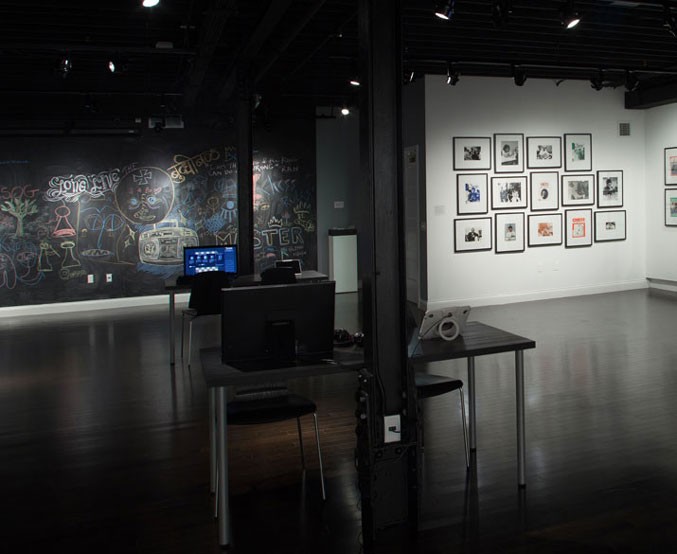
Photography by Michael DeFilippo
History of Chess
With a history spanning over 1500 years, chess is one of the world’s most ancient games. It finds its origins in India, where a game called chaturanga, a predecessor of chess, emerged in the 6th century A.D. During the following century it spread to Persia as shatranj, and later through Arab empires, eventually reaching Europe. As the game was taken up by new players across the globe, the rules changed and pieces gained more dynamic movement. In the 15th and 16th centuries, chess adopted rules closer to its current ones, and authors began to write books analyzing the game.
In the mid-19th century, modern tournament play began, and the now-iconic Staunton chess set was created in England. In 1886, Wilhelm Steinitz won the first World Chess Championship, four games of which were held in Saint Louis. The next century saw the 1924 founding of FIDE (Fédération Internationale des Échecs or World Chess Federation), the international governing body of chess. The invention of the computer, game databases, and powerful chess engines changed the way that players approached the ancient war game in the 20th and 21st centuries. Though chess has evolved greatly since its creation, it maintains an emphasis on the acquisition of knowledge and development of new strategies, while still celebrating the accomplishments of past players.
History of Hip Hop
In the 1970s, hip hop emerged on the streets of New York amidst a community that had suffered from displacement and entrenched poverty resulting from failed urban renewalinitiatives. A cultural movement and a way of life, hip hop gave a voice to young African Americans, whose perspectives had not previously been celebrated in mainstream Americanculture. DJ Kool Herc, who was born in Jamaica and immigrated to New York City, was one of the earliest innovators in hip hop, credited as the creator of breakbeat DJing. AfrikaBambaataa, one of hip hop’s early pioneers and the founder of the Universal Zulu Nation, named MCing, DJing, B-boying, and graffiti as the four main elements of hip hop. He later added knowledge as the fifth element, which unites the other four.
Hip hop gained mainstream acclaim in the late 1970s and early 1980s, with the release of the Sugarhill Gang’s Rapper’s Delight and the premiere of the first rap video on MTV. Hip hop experienced a “golden age” from the mid-1980s to the mid-1990s, when artists released groundbreaking, creative albums that invigorated the form. Today it is both one of the most popular and diverse musical genres, defined by its emphasis on self-teaching, a knowledge of history, and a spirit of competition. Hip hop continues to evolve, with new artists building on the traditions of the past and creating new forms.
Boom!: Photos of American Chess in the post-Bobby Fischer Era
October 9, 2014

Boom! Photos of American Chess in the post-Bobby Fischer Era Gallery View
Photography by Michael DeFilippo
Including photographs and periodicals from the collection of the World Chess Hall of Fame, this wall shows images of players who excelled during the 1970s and 1980s, the same years that hip hop was born and thrived in New York City. Bobby Fischer’s victory in the 1972 World Chess Championship inspired a new generation of young players to take up the game. This group includes four-time U.S. Chess Champion Yasser Seirawan and chess historian and IM John Donaldson. Alongside images of these figures are portraits of players who excelled in Fischer’s own era, including Walter Browne and Larry Evans, as well as Garry Kasparov, who first won the World Chess Championship in 1985.
Make Your Mark
October 9, 2014 - February 22, 2015

Make Your Mark chalk board wall
Make Your Mark was a community-driven installation housed within the Living Like Kings Learning Lab. For its duration, a chalkboard was attached to various walls in the Learning Lab, allowing guests to experience the transient, competitive, and above all creative experience of making graffiti.
Read more about Make Your Mark >
On Chess and Hip Hop
October 9, 2014 - April 26, 2015

On Chess and Hip Hop: Tiffany Foxx
St. Louisans reflect on how the strategies used in the game of chess can mirror the realities of navigating the hip hop industry, lifestyle and art.
Read more about On Chess and Hip Hop >
Pieces and Placement
October 9, 2014 - April 26, 2015

Photography by Michael DeFilippo
Evolving through the course of Living Like Kings, Pieces and Placement features a series of large-scale works inspired by the game of kings. Each month, a new artist will create a work based upon a single chess piece, beginning with the pawn and ending with the king. This installation was curated by Daniel Burnett.
Main Pieces and Placement page >
Street Beautification
October 9, 2014 - April 26, 2015
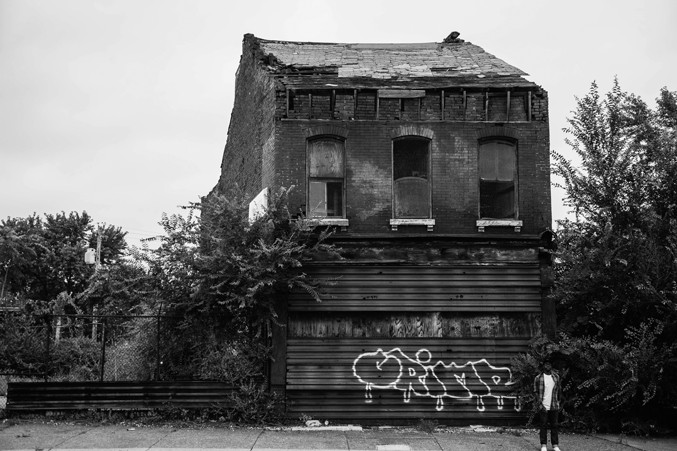
Adrian O. Walker
Self Portrait—Street Beautification 1, 2014
Courtesy of the artist
Street Beautification, an exhibition of photography by Adrian O. Walker, features images of street art from the city of Saint Louis as part of the companion learning lab to Living Like Kings.
Read more about Street Beautification >
Highlights from the World Chess Hall of Fame Collection appearing in Living Like Kings

Photography by Michael DeFilippo
Mahogany Jones
October 22, 2014

Mahogany Jones
Photography by Austin Fuller
An evening of inspirational and uplifting hip-hop by Mahogany Jones and surprise guests. Jones joined us all the way from Detroit to showcase her spoken-word poetry, freestyle skills and singer/songwriter talents.
Read more about Mahogany Jones >
The Covers
January 2, 2015 - February 22, 2015

Photography by Michael DeFilippo
The Covers exhibits colorful, iconic album covers from the collection of James Gates aka Nappy DJ Needles.
Read more about The Covers >
HipSwing
January 22, 2015

HipSwing
Photography by Austin Fuller
Left: Lamar Harris, Right: Thelonius Kryptonite
Thelonius Kryptonite and Lamar Harris teamed up to lead a workshop presenting comparative studies on chess and hip hop, encouraging attendees to listen closely and learn more about figures who blended the two musical genres.
Read more about HipSwing >
Champions in Motion
February 17, 2015
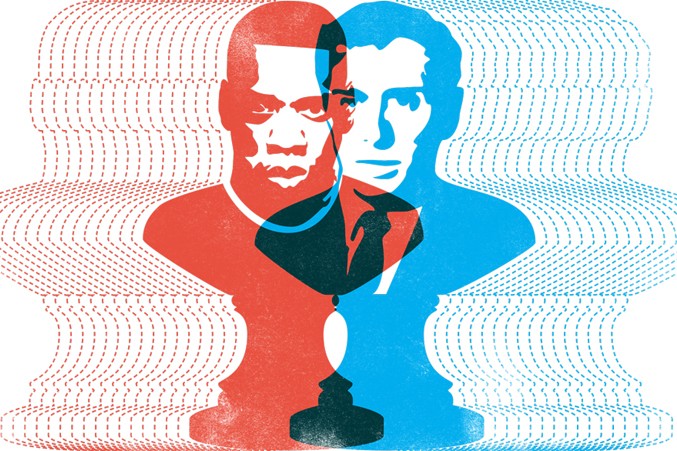
Champions in Motion
Champions in Motion explores the achievements of two figures from different worlds, chess and hip hop. Spotlighting hip hop mogul Jay Z and U.S. and World Chess Hall of Fame inductee Bobby Fischer, the performance and workshop uses examples of moves made from both figures on how they maintained champion status in their fields.
Read more about Champions In Motion >
Freedom Under Rough Years
February 24, 2015 - March 22, 2015

Nicholas Gates
Jay Z, 2009-2010
Ceramic, paint
Collection of the artist
Photography by David Wolk
Freedom Under Rough Years showcases the work of multi-talented local artist Nicholas Gates. Through his work with dance, sculpture, and fashion, Gates celebrates the elements of hip hop, particularly graffiti and b-boying.
Fox2Now interview Nick Gates on Living Like Kings >
Read more about Freedom Under Rough Years >
Brand New Old School Style
March 19, 2015
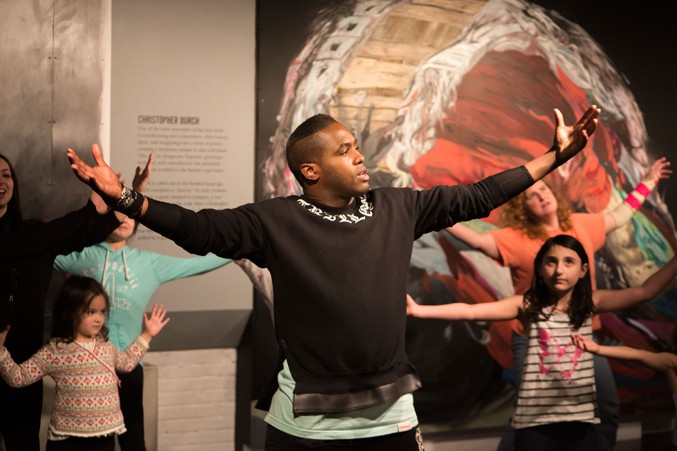
Nicholas Gates
Photography by Austin Fuller
An introduction to the Brand New Old School Style with Saint Louis dancer, choreographer, sculptor, and fashion designer, Nicholas Gates.
Read more about Brand New Old School Style >








 Adisa Banjoko is a pioneer in creating much of the national discussion on the value of hip hop and chess. He has lectured at Harvard University, San Francisco State and other centers of learning to teach its overlapping history and culture. He founded the
Adisa Banjoko is a pioneer in creating much of the national discussion on the value of hip hop and chess. He has lectured at Harvard University, San Francisco State and other centers of learning to teach its overlapping history and culture. He founded the  Daaim Shabazz is a Chicago native and has been involved with chess in various capacities from his time as an Illinois Junior Champion until his latest role as a chess journalist. Thirteen years ago, he launched
Daaim Shabazz is a Chicago native and has been involved with chess in various capacities from his time as an Illinois Junior Champion until his latest role as a chess journalist. Thirteen years ago, he launched  Women’s Grandmaster Jennifer Shahade is a Philadelphia-based writer, games player and commentator. She is a two-time U.S. Women’s Chess Champion, the author of Chess Bitch and Play Like a Girl, and co-author of Marcel Duchamp: The Art of Chess. Jennifer is also the editor of Chess Life Online and has contributed to many publications, including the New York Times and Cardplayer Magazine. Forever in search of new ways to present games, Jennifer created roulette chess with Larry List. She also created hula chess and naked chess with Daniel Meirom, and the two continue to share their game-inspired video art on PokerFairytale.com. Jennifer has traveled the world to perform chess exhibitions and lecture on chess, culture, and strategy. She is particularly invested in promoting chess to girls and women, both through her books and in teaching at 9 Queens Academy, which seeks to empower underserved students.
Women’s Grandmaster Jennifer Shahade is a Philadelphia-based writer, games player and commentator. She is a two-time U.S. Women’s Chess Champion, the author of Chess Bitch and Play Like a Girl, and co-author of Marcel Duchamp: The Art of Chess. Jennifer is also the editor of Chess Life Online and has contributed to many publications, including the New York Times and Cardplayer Magazine. Forever in search of new ways to present games, Jennifer created roulette chess with Larry List. She also created hula chess and naked chess with Daniel Meirom, and the two continue to share their game-inspired video art on PokerFairytale.com. Jennifer has traveled the world to perform chess exhibitions and lecture on chess, culture, and strategy. She is particularly invested in promoting chess to girls and women, both through her books and in teaching at 9 Queens Academy, which seeks to empower underserved students. Maurice Ashley was born in Kingston, Jamaica, raised in Brooklyn, New York, and jumped into history books by becoming the first ever African-American International Grandmaster. He is a firm believer in the character-building potential in chess, and his book Chess for Success crystallizes his vision for the game’s benefits, particularly for at-risk youth. He spreads his love for chess through his Learn Chess! app for smartphones. Ashley also serves as Joint Fellow at Harvard and MIT, a partnership which seeks to fuse games and technology to maximize their potential. Ashley continues to share his motivational message with universities, businesses, chess clubs and non profit organizations around the globe.
Maurice Ashley was born in Kingston, Jamaica, raised in Brooklyn, New York, and jumped into history books by becoming the first ever African-American International Grandmaster. He is a firm believer in the character-building potential in chess, and his book Chess for Success crystallizes his vision for the game’s benefits, particularly for at-risk youth. He spreads his love for chess through his Learn Chess! app for smartphones. Ashley also serves as Joint Fellow at Harvard and MIT, a partnership which seeks to fuse games and technology to maximize their potential. Ashley continues to share his motivational message with universities, businesses, chess clubs and non profit organizations around the globe.

















